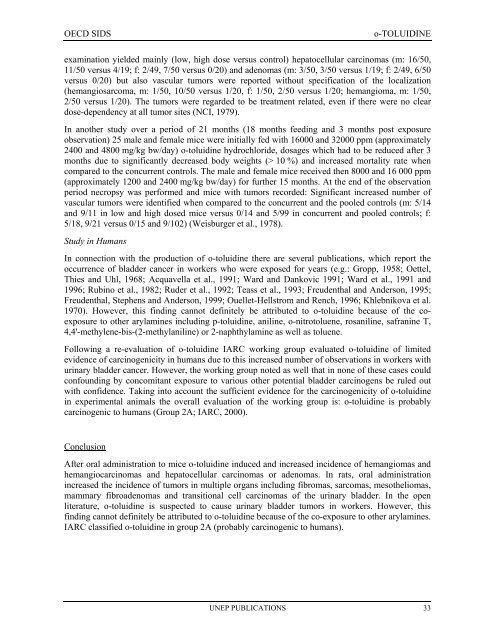o-TOLUIDINE CAS N°: 95-53-4 - UNEP Chemicals
o-TOLUIDINE CAS N°: 95-53-4 - UNEP Chemicals
o-TOLUIDINE CAS N°: 95-53-4 - UNEP Chemicals
You also want an ePaper? Increase the reach of your titles
YUMPU automatically turns print PDFs into web optimized ePapers that Google loves.
OECD SIDS o-<strong>TOLUIDINE</strong><br />
examination yielded mainly (low, high dose versus control) hepatocellular carcinomas (m: 16/50,<br />
11/50 versus 4/19; f: 2/49, 7/50 versus 0/20) and adenomas (m: 3/50, 3/50 versus 1/19; f: 2/49, 6/50<br />
versus 0/20) but also vascular tumors were reported without specification of the localization<br />
(hemangiosarcoma, m: 1/50, 10/50 versus 1/20, f: 1/50, 2/50 versus 1/20; hemangioma, m: 1/50,<br />
2/50 versus 1/20). The tumors were regarded to be treatment related, even if there were no clear<br />
dose-dependency at all tumor sites (NCI, 1979).<br />
In another study over a period of 21 months (18 months feeding and 3 months post exposure<br />
observation) 25 male and female mice were initially fed with 16000 and 32000 ppm (approximately<br />
2400 and 4800 mg/kg bw/day) o-toluidine hydrochloride, dosages which had to be reduced after 3<br />
months due to significantly decreased body weights (> 10 %) and increased mortality rate when<br />
compared to the concurrent controls. The male and female mice received then 8000 and 16 000 ppm<br />
(approximately 1200 and 2400 mg/kg bw/day) for further 15 months. At the end of the observation<br />
period necropsy was performed and mice with tumors recorded: Significant increased number of<br />
vascular tumors were identified when compared to the concurrent and the pooled controls (m: 5/14<br />
and 9/11 in low and high dosed mice versus 0/14 and 5/99 in concurrent and pooled controls; f:<br />
5/18, 9/21 versus 0/15 and 9/102) (Weisburger et al., 1978).<br />
Study in Humans<br />
In connection with the production of o-toluidine there are several publications, which report the<br />
occurrence of bladder cancer in workers who were exposed for years (e.g.: Gropp, 1<strong>95</strong>8; Oettel,<br />
Thies and Uhl, 1968; Acquavella et al., 1991; Ward and Dankovic 1991; Ward et al., 1991 and<br />
1996; Rubino et al., 1982; Ruder et al., 1992; Teass et al., 1993; Freudenthal and Anderson, 19<strong>95</strong>;<br />
Freudenthal, Stephens and Anderson, 1999; Ouellet-Hellstrom and Rench, 1996; Khlebnikova et al.<br />
1970). However, this finding cannot definitely be attributed to o-toluidine because of the coexposure<br />
to other arylamines including p-toluidine, aniline, o-nitrotoluene, rosaniline, safranine T,<br />
4,4'-methylene-bis-(2-methylaniline) or 2-naphthylamine as well as toluene.<br />
Following a re-evaluation of o-toluidine IARC working group evaluated o-toluidine of limited<br />
evidence of carcinogenicity in humans due to this increased number of observations in workers with<br />
urinary bladder cancer. However, the working group noted as well that in none of these cases could<br />
confounding by concomitant exposure to various other potential bladder carcinogens be ruled out<br />
with confidence. Taking into account the sufficient evidence for the carcinogenicity of o-toluidine<br />
in experimental animals the overall evaluation of the working group is: o-toluidine is probably<br />
carcinogenic to humans (Group 2A; IARC, 2000).<br />
Conclusion<br />
After oral administration to mice o-toluidine induced and increased incidence of hemangiomas and<br />
hemangiocarcinomas and hepatocellular carcinomas or adenomas. In rats, oral administration<br />
increased the incidence of tumors in multiple organs including fibromas, sarcomas, mesotheliomas,<br />
mammary fibroadenomas and transitional cell carcinomas of the urinary bladder. In the open<br />
literature, o-toluidine is suspected to cause urinary bladder tumors in workers. However, this<br />
finding cannot definitely be attributed to o-toluidine because of the co-exposure to other arylamines.<br />
IARC classified o-toluidine in group 2A (probably carcinogenic to humans).<br />
<strong>UNEP</strong> PUBLICATIONS 33
















